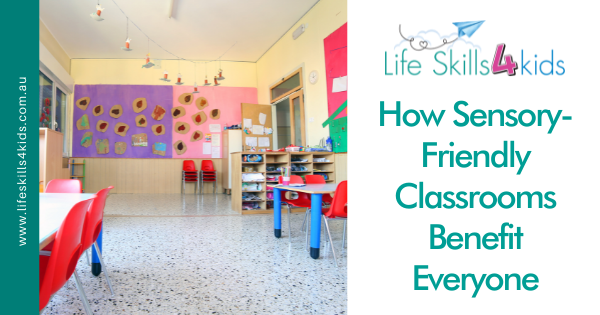While recent advances in educational strategies have focused on the needs of children with Autism or Sensory Processing Disorder, there are actually many children who don’t have either of these conditions but may be sensory-sensitive in one or two areas. These children, along with other children that don’t have any issues, can benefit from the sensory-friendly adjustments that accommodate the special needs of autism and SPD. Sensory-friendly classrooms can improve learning outcomes for all children, not just those with special needs.
Aiming for Good Outcomes in the Classroom
When a child is sensory-sensitive or has SPD or autism, it is easy for sensory issues to become overwhelming to the point that learning stops. These kids struggle with sensory overwhelm on a daily basis and if this is not addressed, the result is behavioural problems or an inability to learn because the child is constantly stressed or afraid of adverse sensory experiences. Other kids can be sensitive to sensory input for different reasons; for example, a child with allergies can struggle with air quality or odours. An introverted child may struggle with noise or being too close to other children, while a child with ADHD might find a visually busy classroom challenging.
A sensory-friendly classroom aims to change the learning outcomes for these kids and even to improve the learning environment for all the kids in the class. When children are comfortable in their environment, they don’t have to worry about an adverse experience that might suddenly occur and they can focus on learning.
Small Changes Can Make a Big Difference
Teachers that are aware of the sensory needs of their students will often notice that small changes can make a big difference to behaviour problems. In fact, when behaviour issues arise, these teachers usually check the classroom environment for sensory triggers and the behaviour issues frequently disappear or are reduced. It might be something as simple as moving a student to an area of the classroom that isn’t as bright or changing the style of seating that a student uses, or creating a more sensory-friendly classroom layout.
Sensory-Friendly Classrooms are Not Only For Special-Needs Children
Many students find that sensory elements of a classroom are distracting, even if they don’t have SPD or autism. It might only be in one area, such as noise or odours, but it is enough to hinder learning. The following areas of sensory sensitivity can apply to all students:
Noise
A noisy classroom can be distracting to everyone. This can depend on the way a teacher manages classroom behaviour, but noise can also come from the classroom environment. Wooden floors, noisy overhead fans, classroom location near a corridor or stairs or proximity to a busy road can all contribute to the distractions of noise. Try these tips to manage noise:
- Place mats on noisy wooden floors and put pads on the feet of the chairs
- Play soft music or nature sounds to cover the sounds from noisy hallways or stairs
- Have rules such as no talking at specific times or only one person to speak at a time
Lighting
Some students are “solar powered.” They are most alert and ready to learn when they are in bright natural light. Others do better in softer lighting, finding bright light harsh and distracting. Lighting preference can play a big part in how comfortable a child feels in the learning environment. Lighting tips:
- Have one area of the room lit with fluorescent lighting
- Use blinds in one area
- Try lighting with a dimmer switch or diffuser
Odours
Some children are extremely sensitive to odours and this can continue into adulthood. Classrooms are a mixture of many odours and this can be overwhelming to some children. For these kids, it is enough to distract them from learning. To manage odours:
- Allow fresh air into the classroom
- Use a fan to circulate air
- Create rules such as no food in the classroom or odourless personal products while at school
Visual Elements
Some kids love to feast their eyes on a rich visual display. But for others, it can be overwhelming and a distraction from learning. Classrooms have traditionally used lots of bright colours and have filled up much of the available wall space with visuals, pictures and children’s artworks. But for some kids, this might not provide the best learning outcomes. Make your space more visually friendly:
- Leave blank spaces on some walls
- Make sure that colours and patterns coordinate rather than clashing
- Keep clutter under control
Helping Children to Thrive in the Classroom
As most teachers would agree, the right environment for learning is crucial. Check out my 20 Day Classroom Detox program; it is packed full of useful strategies and advice to maximize learning outcomes. If you would like to know more, feel free to contact us. We would love to hear from you!

